Of course they’ve always been real worlds. They just never looked that way. We’ve only known of their existence since 2005, when astronomers with the Pluto Companion Search Team spotted them using the Hubble Space Telescope. Never more than faint points of light, each is now revealed as a distinct, if tiny, world.
“Before last week, Hydra was just a faint point of light, so it’s a surreal experience to see it become an actual place, as we see its shape and spot recognizable features on its surface for the first time,” said New Horizons mission science collaborator Ted Stryk.
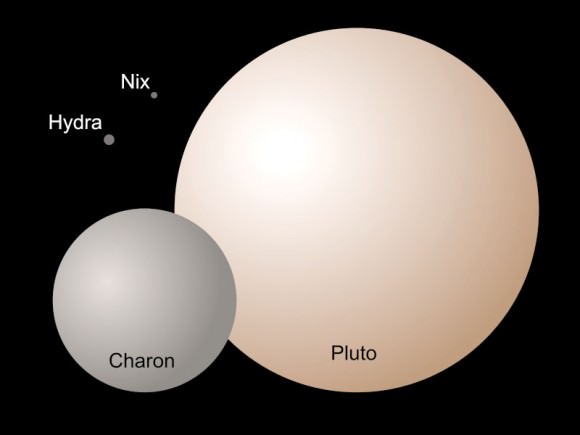
Nix looks like a strawberry-flavored jelly bean, but that reddish region with its vaguely bulls-eye shape hints at a possible crater on this 26 miles (42 km) long by 22 miles (36 km) wide moon. Hydra, which measures 34 x 25 miles (55 x 40 km), displays two large craters, one tilted to face the Sun (top) and the other almost fully in shadow. Differences in brightness across Hydra suggest differences in surface composition.
Now we’ve seen three of Pluto’ family of five satellites. Expect images of Pluto’s most recently discovered moons, Styx and Kerberos, to be transmitted to Earth no later than mid-October.
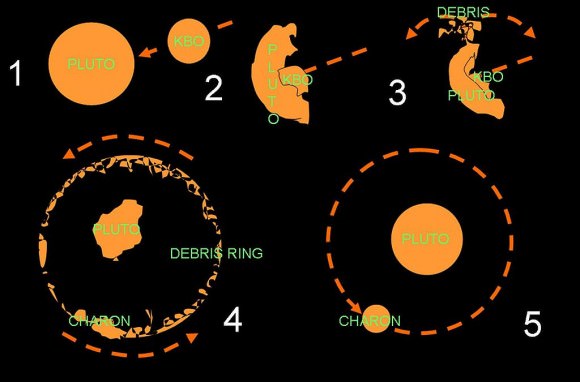
All of Pluto’s satellites are believed to have been created in what’s now referred to as “The Big Whack”, a long-ago collision between Pluto and another planetary body. A similar scenario probably played out at Earth as well, leading to the formation of our own Moon. In Pluto’s case, most of the material pulled together to form Charon; the leftover chips became the smaller satellites. Their sizes are too small for self-gravity to crush them into spheres, hence their irregular shapes. The moons’ neatly circular orbits about Pluto suggest they formed together rather than being captured willy-nilly from the Kuiper Belt.
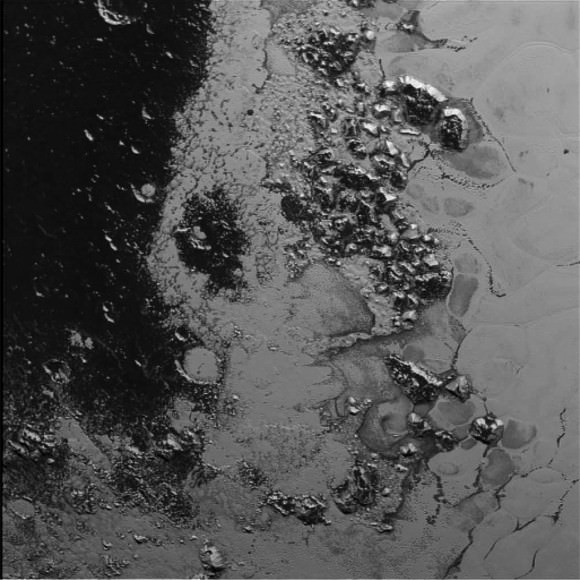
Credits: NASA/JHUAPL/SWRI
Update: This just in. Take a look at this new close-up of Pluto that features a newly discovered mountain range in southwestern Tombaugh Regio. Sure looks like ice flows. This is a complex little dwarf planet!
Below we have a special treat just in this morning (July 22) — mosaics and montages of Pluto and family created by Damian Peach from New Horizons images. Be sure to click to see the hi-res versions. Enjoy!
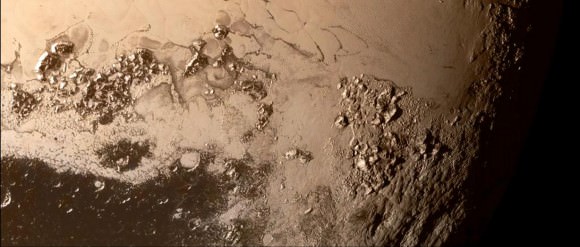
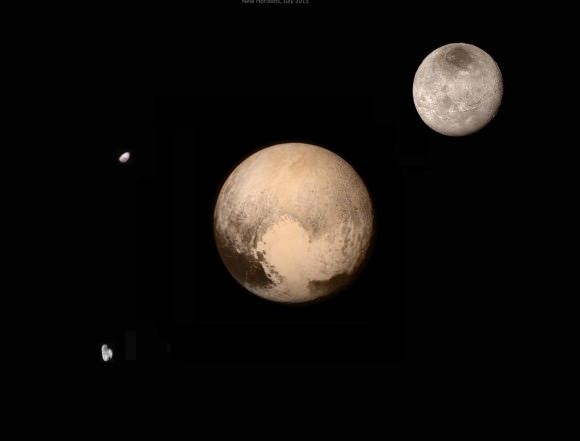

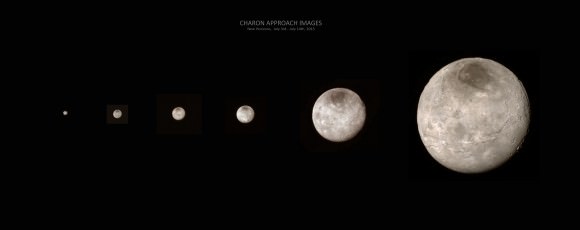

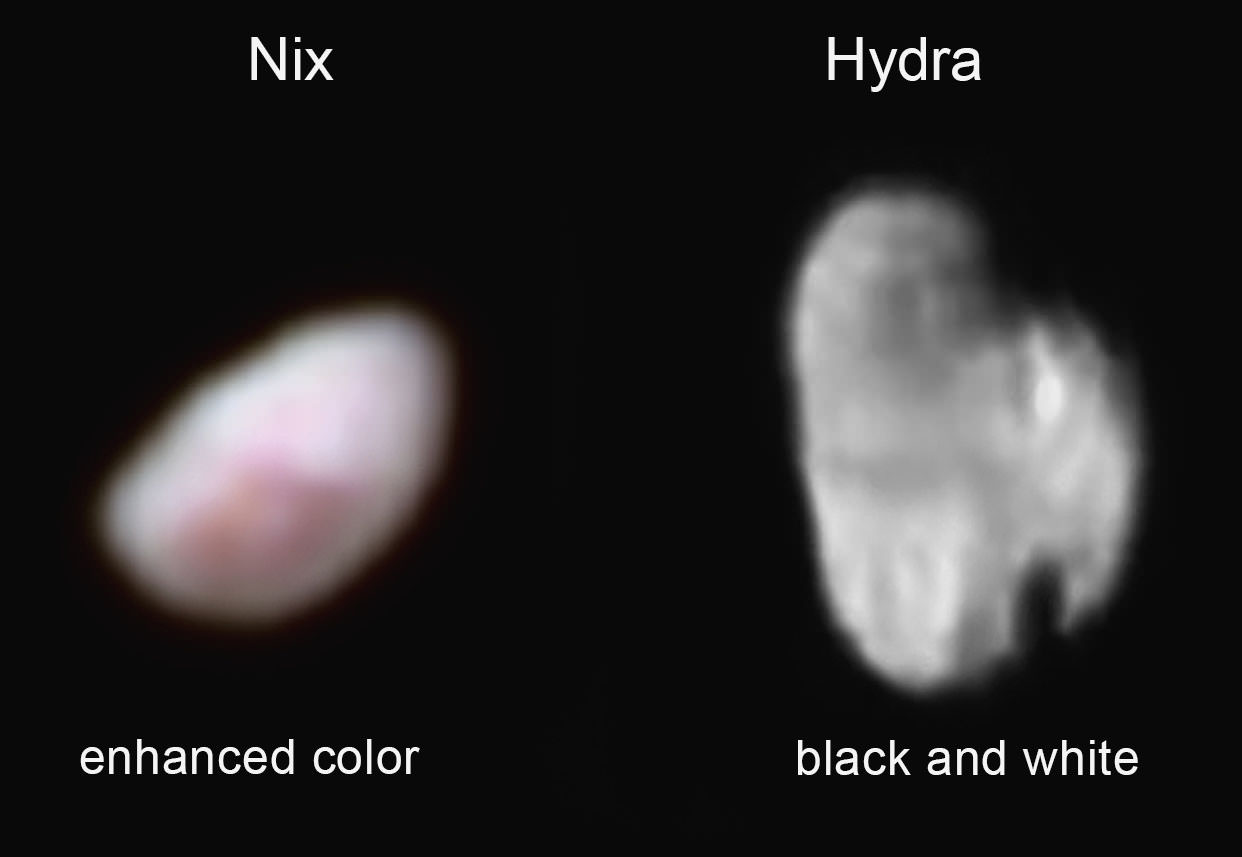
Bob, thank you for the neat pictures of the little moons. Only two to go!
But … in the five-stage picture of the formation of Pluto and Charon it is difficult to see enough material in frame four to result in the large globe of Pluto in frame five. The credit is given to Wikipedia. Does that mean that any contributor to Wikipedia is then shielded and lost forever?
My real point is that the five stages shown are many too few and too stark to get the real story across. You need a better illustration – OR – just the reference to the Earth Moon system.
We commenters sure are picky, aren’t we?
Thanks for releasing this stuff, AND explaining it, as quickly as it becomes available. You are MY best source. And this is information for which I have spent a lifetime of anticipation.
Hi Pete,
Thanks! I agree the diagram is pretty basic, but for the moment the best I could get my hands on without creating it myself. I just wanted to give readers a simple graphical look at the “big whack”.
The problem with Wikipedia is that some of the people that create work there (even really nice stuff at times) use fake names. Very frustrating. In that case, as long as the image/diagram is in the public domain, I’ll use the generic “Wikipedia” credit.
Seems a bit of a stretch to refer to these very small, oddly shaped rocks as “worlds”. Also, wonder if these are the closest images taken…or are there closer images on the way? Same for Pluto and Charon?
Hi 2stepbay,
I don’t have a problem with calling them worlds. A “world”, at least in my view, is a celestial body with its own unique and complex environment. The term dramatizes the difference between what we knew of Nix and Hydra before the flyby (virtually nothing) compared to how we see them now.
I can’t answer the first part of your second question about whether we’ll be seeing more images of these two moons from closer up, but there will be much better photos of Pluto and Charon coming. If I’m not mistaken we haven’t seen any pictures yet taken during closest approach of 7,800 miles.
“Big Whack” or “Big Bump”? How would a normal KBO gain enough relative momentum to smash up Pluto? Does this imply there are other undiscovered large mass bodies out there? Or is it somewhat more likely to have been caused by a body pulled in, gravity boosted, and slung out from the inner solar system? A simple scenario originating via disturbance of a passing star. If so, imagine the odds and number of objects it would take for one to zoom in near the sun, get a planetary gravity boost and finally whack Pluto. A recent article here described such a passing star encounter about 70K years ago – does this portend KBOs visiting the inner solar system in our future?
In the same way that Earth was hit and reformed with our Moon in the ancient past (to answer your first question) thanks for the article Bob and welcome back…
Thanks UFO’sM!
I think a KBO turned impactor would have much higher velocity in the inner solar system (near earth) than it would have orbiting back out near its origins the Kuiper belt. Pluto being hit so hard where it is seems unusual compared to the earth/moon.
Maybe not. Considering Earth’s relatively “normal” orbit, it’s likely the two colliding protoplanets formed in similar orbits. If so, their relative motion would have been low with most of the impact velocity due to mutual gravitation.
Pluto’s orbit is very skewed though. An encounter with Neptune might have put one of its precursors onto a violently intersecting path. Pluto’s gravity well is also much shallower than Earth’s, so much less impact velocity would have been required.
The geometry of the impact makes a big difference too. The resulting blob only needs to be spun up enough that its equator would exceed orbital velocity and two bodies (or at least one with rings) are guaranteed. So a fairly slow but glancing collision will work, but a high velocity direct hit won’t.
LapsedPacifist 2:
So we may need “… A [close] encounter with Neptune … ”
then “… a fairly slow but glancing collision will work, but a high velocity direct hit won’t.”
I’m getting it now, but isn’t this more like a “Big Bump” than a “Big Whack” to create Pluto and its moons? I envision a collision more like Jello globs intersecting than a bullet and clay pigeon. All of this still may require some extra-solar system interaction to stir up such collisions (beyond our system’s primal formation).
caw,
The solar system was a much busier place with far more asteroids (potential impactors) roaming about compared to today. Also, consider the migration of Jupiter and Saturn to their current positions from the time when they were closer to the Sun. Wholesale movement of vast amounts of small bodies were either flung out of the solar system altogether or ended up in the Kuiper Belt during the migration. OR, as you suggested, a passing star may have been to blame.
If so, wouldn’t that passing star have dragged any of our planets with it?
Ponce, How are we to know that it did not? there could have been a lot more Planets in our Solar System back then and maybe some were evicted by a passing Star!…
I can’t wait to see a spectroscopic analysis of the materials/ices(?) that make up Tombaugh Regio AND if possible the same for Nix! That red coloration on Nix reminds of organic hydrocarbon deposits as seen on other cometary bodies? Perhaps methane or ethane ice after it has been exposed to solar radiation? Cool chemistry, is an understatement!
Reminds, the best is yet to come!
I LOVE MIKE BROWN
http://i2.photobucket.com/albums/y33/HeadAroundU/i%20love%20mike%20brown.png
WE LOVE MIKE BROWN
http://i2.photobucket.com/albums/y33/HeadAroundU/i%20love%20mike%20brown.png
good link
http://i2.photobucket.com/albums/y33/HeadAroundU/we%20love%20mike%20brown.jpg
Hey Bob, look at my new art. 🙂
Hey “Head”,
You might as well be saying that you love THE DONALD.
You post is inappropriate here, and definitely not appreciated.
I guess you mean Trump, not the duck. 😀 Obama is my boy. Let’s see if the USA can find a sane republican.
I may have missed some information but I’ll ask anyway. If Pluto is not a planet, how can moons be ascribed to it? Wouldn’t the ‘moons’ just as well have Pluto as their moon?
Hi Ponce,
Good question. Dwarf planets and ordinary asteroids can have moons. Pluto’s one, and there are a bunch of asteroids with tiny moons including Ida with its little satellite Dactyl photographed by the Galileo spacecraft. Here’s a list: http://www.johnstonsarchive.net/astro/asteroidmoons.html
The key reason Pluto disqualifies as a planet is that it hasn’t cleared its orbital neighborhood of other asteroids.